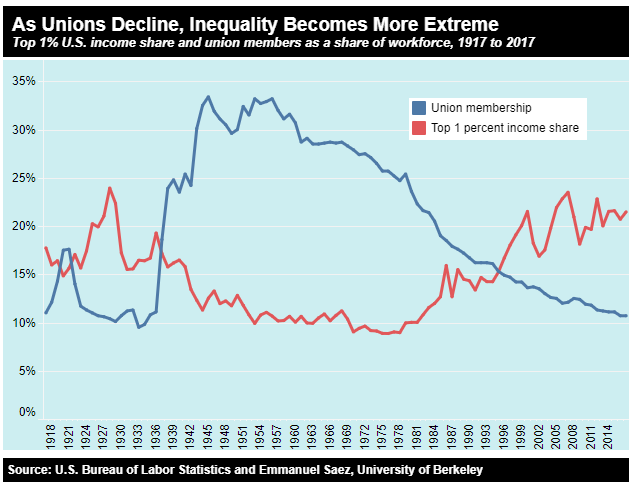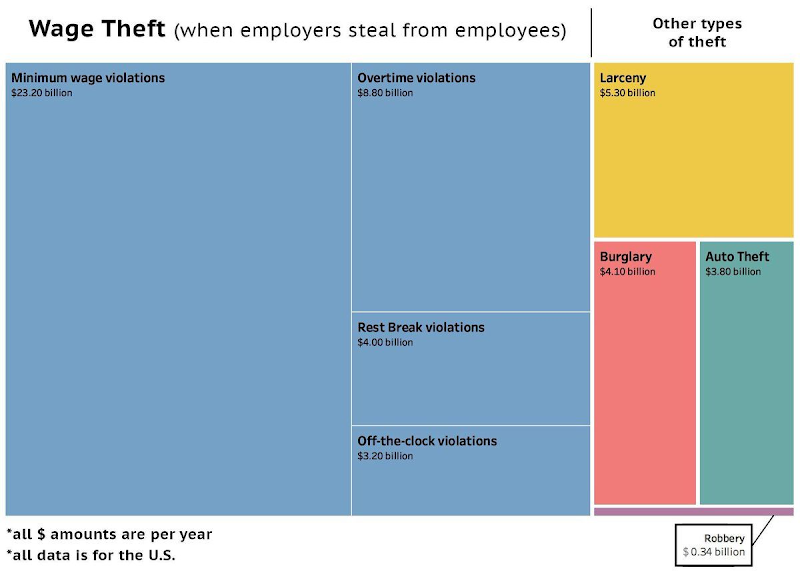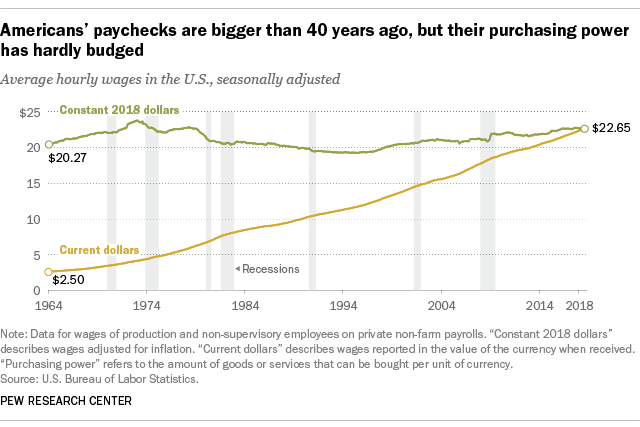source-library
WEALTH INEQUALITY
General
General
Inequality is rising and concentrating wealth at the top of the wealthy class, which contributes to worse economic mobility
-
Inequality.org |
 |
|  |
|:——————————————————————————————————————:|:——————————————————————————————————————:|
|
|
|:——————————————————————————————————————:|:——————————————————————————————————————:|
|  |
|  |
| - Madsen 16 (related article by study contributor)
- Looks at savings, investments, education, and knowledge production in 21 OECD countries spanning 142 years
- Finds that wealth inequality can negatively impact growth, but that this can be offset in certain states of financial development, usually in which people have access to the money or credit needed to move up
- Serves better as a counter to extreme wealth inequality than it does to wealth inequality in general - good for defending social safety nets, as those help reduce extreme inequality and offer needed resources to move up
- Pickett 15
- Literature review of wealth inequality in relation to health
- Finds that there is strong evidence of wealth inequality having a causal relation to worse health
- This relation is especially strong in countries with significant wealth inequality
- Corak 13
- Discusses trends in wealth inequality and social mobility
- Finds a large body of evidence that suggests that wealth inequality is worse for economic mobility, and that increased wealth inequality can diminish the impact of hard work relative to the reward for such work
- “Inequality lowers mobility because it shapes opportunity. It heightens the income consequences of innate differences between individuals; it also changes opportunities, incentives, and institutions that form, develop, and transmit characteristics and skills valued in the labor market; and it shifts the balance of power so that some groups are in a position to structure policies or otherwise support their children’s achievement independent of talent.”
- Haas Institute Director: Powell 14
- Provides a number of evidence-based policies for reducing wealth inequality. These include increasing the minimum wage, investing in education, and making the tax code more progressive
- Doesn’t cite sources unfortunately, but still a useful policy brief
- Multiple studies demonstrate that lower socioeconomic status is heavily correlated with worse academic achievement, and that this makes it harder for poor people to become wealthy later on in life - this suggests that education isn’t necessarily meritocratic, and systemically disadvantages poor people (1) (2) (3) (4)
- Matt Korostoff: Wealth Shown to Scale
- Interactive which provides a great visual of wealth inequality in the US
- If we redistributed even small portions of the wealth held by the richest 400 Americans, it could radically benefit economic growth and save/improve the lives of tens of millions
- A more extreme example of how the top 400’s wealth could be redistributed. Even doing just one of the things in this pie chart would help tens of millions of people, while leaving the richest 400 Americans as billionaires.

- Pew Social Trends 2020, pre-covid (many links included)
- Though some indicators (e.g. unemployment rate) were looking good at the time, wealth inequality is still on the rise
- Income growth was most rapid for the top 5% of families
- Even with median household income levels increasing, the wealth of median American families was not much different from such 20 years ago
- Chetty et al. 14
- Detailed look into what areas of the US have the most upward mobility. It did this by analyzing certain indicators of people born in the 1980s and by following the indicators of that group until 2010
- Found that generally speaking, the South had the worst upward mobility while rural areas in the Great Plains usually had the best upward mobility


- February 2015 US Poverty Factsheet (basically post recession by that point)
- At the time, 45.3 million Americans lived in poverty. An additional 97.3 million Americans lived in what would be considered ‘low income’
- The top 1% of people owned 43% of the wealth while the bottom 80% of people owned 7%
- Globally, the top 80 people had more wealth than 3.5 billion people. This was up from the top 388 people in 2010
- 60% of all jobs created from 2008-2012 paid minimum wage
- 62% of all bankruptcies in 2007 were due to medical debt, in spite of most of those people having health insurance
- https://jamanetwork.com/journals/jama/article-abstract/2513561
- “higher income was associated with greater longevity throughout the income distribution. The gap in life expectancy between the richest 1% and poorest 1% of individuals was 14.6 years for men and 10.1 years for women.”
- “inequality in life expectancy increased over time. Between 2001 and 2014, life expectancy increased by 2.34 years for men and 2.91 years for women in the top 5% of the income distribution, but by only 0.32 years for men and 0.04 years for women in the bottom 5%.”
- Hobjin & Alexander 15
- The Stimulative Effect of Redistribution
- https://www.tandfonline.com/doi/full/10.1080/00213624.2020.1743142
- This study looked at income inequality by examining the 100 lowest and 100 highest per capita income counties in the United States from 1969 to 2017. It found that “Both groups of counties changed slowly from decade to decade and over the nearly fifty years examined.” Because the inequality was so slow to change, the researchers conclude:
- “Fifty years from now, the people of the lowest income counties are still likely to be members of racial and ethnic minority groups. And, fifty years from now the people of the lowest income counties are likely to remain less well-educated than the people of the highest income counties or the nation.”
- “Dramatic technological and institutional changes over the last fifty years have not altered the nature of regional income inequality in a substantial way, nor are such changes likely to do so during the next fifty years.”
- https://www.pewtrusts.org/en/projects/archived-projects/financial-security-and-mobility general thing to look at down the road
Wages
Wages
A majority of workers are in debt and struggling to get by; many work multiple jobs
- CareerBuilder Poll Data 17
- 78% of U.S. workers live paycheck to paycheck to make ends meet
- Nearly 10% of workers making $100,000+ live paycheck to paycheck
- More than 25% of workers do not set aside any savings each month
- Nearly 75% of workers say they are in debt today
- More than 50% think they will always be
- More than 50% of minimum wage workers say they have to work more than one job to make ends meet
- 70% of minimum wage workers are in debt
- “The Poverty Myth” - Maggiulli 17
- 20% of american households spend more than they earn on basic necessities

- The next 20% aren’t doing much better than the bottom 20%, they are able to keep very little, if any, of their income as savings
- These numbers take into account stuff like taxes, government benefits, etc
- These sorts of problems are worsened by the fact that some poor communities simply don’t have access to inexpensive food. Depending on the specific city/community, the low-income neighborhoods are left with independently owned smaller grocery stores that tend to have higher prices. Poor consumers are left with the option of traveling to middle-income neighborhoods, or spending more for less.
- 20% of american households spend more than they earn on basic necessities
- [VIDEO] This Is How Long It Would Take You To Earn A Billion Dollars by Second Thought
- Even working $2000 an hour for a 40-hour work-week consistently for 52 weeks a year (and spending no money), it’d still take a few centuries to reach billionaire status. Recognizing that no normal person could actually do this, it should come as no surprise that billionaires didn’t simply ‘work hard’ or even work within conventional means to attain their money.
Executive Pay:
- Economic Policy Institute: Mishel and Davis 15
- Top CEOs make more than 300 times that of the average worker
- Economic Policy Institute: Mishel and Schieder 17
- Since 1960, CEO compensation vs worker compensation has increased from 20x higher to 270x higher - compared to their workers, are CEOs 13x more productive today than they were in 1960?
- Also shows that an upper capitalist class can be wealthy without having an exorbitant amount of money go their way, as it was in 1960
Growth
Growth
The rich are getting richer far faster than the poor, while poverty is steady
-
Inequality.org |
 |
|  |
|  |
|——————————————————————————————————————–|:——————————————————————————————————————:|:——————————————————————————————————————:|
|
|——————————————————————————————————————–|:——————————————————————————————————————:|:——————————————————————————————————————:| - USA Today: Hjelmgaard 18
- in 2017, 82% of global wealth created went to the top 1%
- “There are now 2,043 billionaires worldwide… Collectively, their fortunes grew by $762 billion in 2017, while the poorest half of humanity saw no increase in their wealth at all.”
- Oxfam 18
- 82% of the wealth generated in 2017 went to the richest one percent of the global population.
- The 3.7 billion people who make up the poorest half of the world saw no increase in their wealth in 2017.
Stocks and Investment
Stocks and Investment
Control over businesses and the stock market is also heavily concentrated among the richest of the rich
- Inequality.org
- Rich have far more lucrative options for income – not only is growth higher, but it is rigged in their favor
|
 |
|  |
|——————————————————————————————————————–|:——————————————————————————————————————:|
|
|——————————————————————————————————————–|:——————————————————————————————————————:|
- Rich have far more lucrative options for income – not only is growth higher, but it is rigged in their favor
|
- https://scholar.harvard.edu/files/straub/files/mss_richsavingglut.pdf
- “Rising income inequality since the 1980s in the United States has generated a substantial increase in saving by the top of the income distribution, which we call the saving glut of the rich. The saving glut of the rich has been as large as the global saving glut, and it has not been associated with an increase in investment. Instead, the saving glut of the rich has been linked to the substantial dissaving and large accumulation of debt by the non-rich. Analysis using variation across states shows that the rise in top income shares can explain almost all of the accumulation of household debt held as a financial asset by the household sector. Since the Great Recession, the saving glut of the rich has been financing government deficits to a greater degree.”
Unions
Unions
Unions are on the decline while inequality remains extreme
- Inequality.org
- CAUSATIVE Negative Relationship Between Union Membership and Skewed Growth*
- “As the share of the workforce represented by a union has declined to less than 11 percent since their peak in the 1940s and 1950s, those at the top of the income scale have increased their power to rig economic rules in their favor, further increasing income inequality.”

- “As the share of the workforce represented by a union has declined to less than 11 percent since their peak in the 1940s and 1950s, those at the top of the income scale have increased their power to rig economic rules in their favor, further increasing income inequality.”
- CAUSATIVE Negative Relationship Between Union Membership and Skewed Growth*
- https://www.americanprogressaction.org/issues/economy/news/2013/09/17/74363/latest-census-data-underscore-how-important-unions-are-for-the-middle-class/
- union membership has a direct link to middle class share of income
- EPI 03
- Unions raise wages of unionized workers by roughly 20% and raise compensation, including both wages and benefits, by about 28%.
- The most sweeping advantage for unionized workers is in fringe benefits. Unionized workers are more likely than their nonunionized counterparts to receive paid leave, are approximately 18% to 28% more likely to have employer-provided health insurance, and are 23% to 54% more likely to be in employer-provided pension plans.
- Unionized workers receive better pension plans. Not only are they more likely to have a guaranteed benefit in retirement, their employers contribute 28% more toward pensions.
- Unionized workers receive 26% more vacation time and 14% more total paid leave
Wage Theft (non-marxian)
Wage Theft (non-marxian)
This section deals with wage theft in the non-marxian sense, where employers just refuse to pay their employees what they both agreed to. Unfortunately, this costs workers billions of dollars
- Economic Policy Institute 14
- Even small levels of wage theft can mean the difference between meeting rent and getting evicted, especially for minimum wage workers
- “Survey evidence suggests that wage theft is widespread and costs workers billions of dollars a year, a transfer from low-income employees to business owners that worsens income inequality, hurts workers and their families, and damages the sense of fairness and justice that a democracy needs to survive.”
- An estimated $50 billion is stolen from 30 million low-income workers annually in the US, far exceeding costs from typical theft or robbery

- Image source
